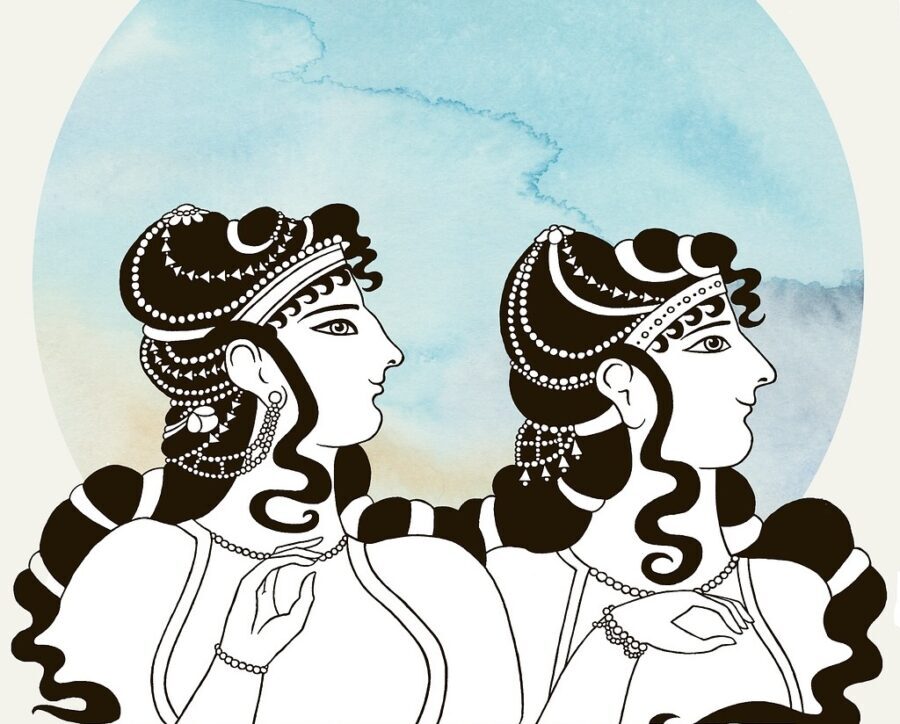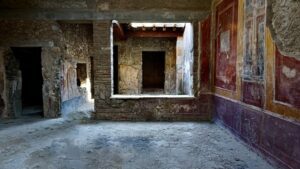
“It is impossible to see those deformed figures, and not feel moved. They have been dead for eighteen centuries, but they are human beings seen in their agony…….. it is the pain of death that takes on body and form. Up to now temples, houses and other objects have been found that have aroused the curiosity of educated people, artists and archaeologists; but now you, my dear Fiorelli, have uncovered human pain, and every man feels it.”.
— Luigi Settembrini, “Letter to the Pompeians”, 1863
Pompeii.
In the mind’s eye, the name conjures up immediate images of plaster cast human figures writhing in agony in their final moments of life — the hapless and unsuspecting citizen-victims of an ancient Roman city — bodies prone, twisted and arched; hands clenched as fists; faces locked in agonizing grimaces. They have all been frozen in time, ironically preserved by the destructive force and elements of the Vesuvius eruption of 79 AD.
In equal measure, however, one marvels at the buildings, estimated to extend 64 to 67 hectares (160 to 170 acres), two-thirds of which have been excavated. Walls, many of them preserved to the second and third levels; villa interior spaces still adorned, at least partially, with what remains of the sumptuous, masterfully rendered, colorful frescoes that were commissioned to impress and to glorify the wealth of the privileged few; and fountains and statues showcasing 1st Century Roman engineering and artistic achievement.
But majestic villas are but a small part of what can be seen here. There are shops, bakeries, food vendors, brothels, public baths, public toilets, as well as grand public and administrative centers and massively constructed edifices for entertainment. Inside these structures, archaeologists uncovered countless artifacts of everyday living — carbonized objects, including food and furniture and other, smaller personal items.
Most accounts describe the great eruption as lasting two days. At first, most inhabitants would have experienced a rain of small fragments of pumice (lapilli), increasing in size through time and lasting about 18 hours. This gave most people enough time to escape the city, taking their most valuable belongings. But there were some, for whatever reasons, who lingered. Approximately 1,150+ human remains have been found or excavated in Pompeii to date. Many of them were found with their jewelry, coins, and silverware.
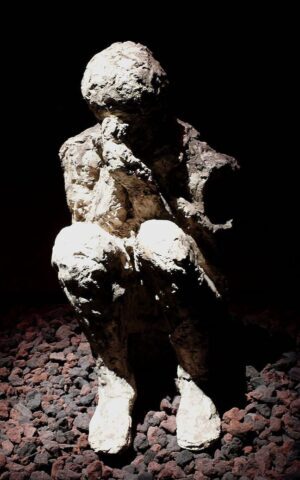
Cast of a corpse recovered from Pompeii. Ken Thomas, Public Domain
Later, during the night or early the following day, high-speed pyroclastic flows of super-heated, dense ash erupted from the volcano and down through the city, collapsing whole or in part the structures of the city and extinguishing the remaining inhabitants. The city was entombed in a shroud of pumice and ash, and by the time the silence of early evening fell, the air was a thick haze through which the sun could only struggle to penetrate.
Extensive research has indicated that heat was the main cause of death for those who remained to face the volcanic onslaught, with a temperature of at least 250 °C (480 °F) causing instant death, even within the delusive protective shelter of buildings.
Pompeii was buried in as much as twelve layers of tephra, totaling about 6 meters (19.7 ft) deep. (See video below for one version of the eruption. The dates may be inaccurate).
This dramatic story of Pompeii and its prolific, remarkably well preserved remains explains why, as an archaeological park, it enjoys more than 2.5 million visitors a year. Its popularity is born of other obvious reasons — no other archaeological site on the planet has revealed as much in terms of both volume and diversity of objects and structures in one place. In essence, it paints an ever-developing, still unfinished portrait of the daily life of a community that thrived 2,000 years ago. The more visitors and scholars see and know, the more they realize something that is at the heart of why there is such fascination that surrounds this place — these people were much like us, and they suffered an unspeakable catastrophe.
_________________________________
_________________________________
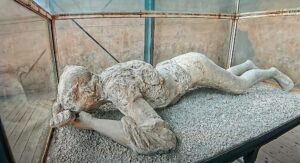
Cast of individual found in the changing room of the Stabian Baths in Pompeii. Mary Harrsch, Creative Commons Attribution-Share Alike 4.0 International, Wikimedia Commons
_________________________________
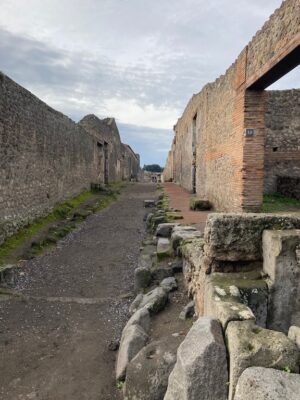
Above and below: Typical views as one walks along the ancient streets of Pompeii.
_________________________________
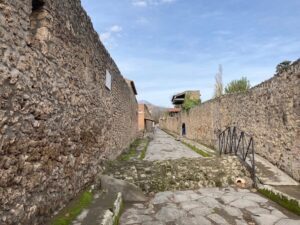
_________________________________
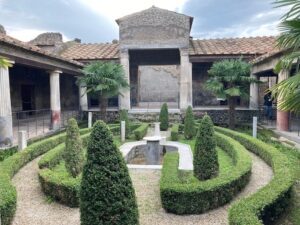
Above and below: The restored remains of the sumptuous villas of Pompeii would be reason alone to visit the ancient city.
_________________________________
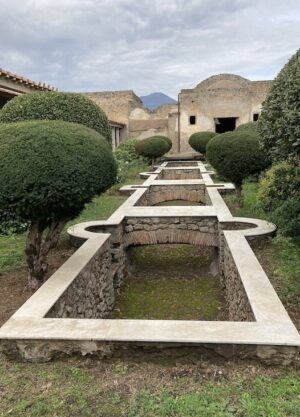
_________________________________
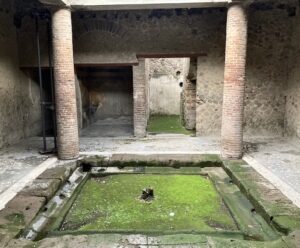
_________________________________
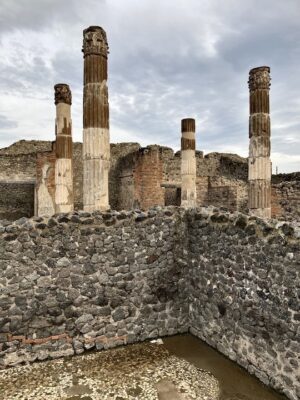
Above and below: A slice of the massive restored public buildings and centers of the ancient city.
_________________________________
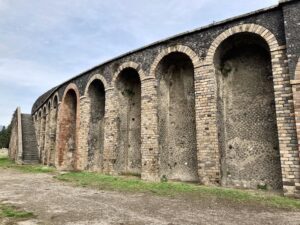
_________________________________
New Discoveries
Archaeologists have been excavating and investigating this massive site using systematic methodologies since the mid-18th century. Their work has produced prolific results — approximately two thirds of the estimated area of the city, which supported about 11,000 people in its day, has been uncovered thus far. Through the decades, techniques, technology, and objectives and strategies have changed in step with the times. These changes, along with renewed efforts and new objectives related to conservation, protection and restoration, have played a role in some fascinating new discoveries that have been made in recent years……….
Discoveries in Regio V
Through the ‘Great Pompeii Project’, more than 1.6 miles of ancient walls within the city were rescued from impending danger of collapse from the pressure of groundwater and earth movement by addressing the unexcavated areas behind the associated street fronts. This operation included excavations in the unexcavated areas of Regio V, a sector of Pompeii where a number of fascinating new discoveries were made in the process.
____________________________
____________________________
Archaeologists encountered several finds in Regio V that have caught the special attention and imagination of the public and scholars alike:
A Snack Bar
It goes without saying that restaurants and food establishments are favorite destinations and resting stops for everyone today, whether one is on foot or traveling in a vehicle. This was equally so for the citizens of Pompeii nearly 2,000 years ago. One cannot walk far along the streets of ancient Pompeii today without encountering the remains of a restaurant or food bar, especially thermopolia, (a Greek term that means a place where one can purchase hot, ready-made food). Thermopolia were very common in the Roman world, and Pompeii at current count had no less than eighty of them. Their features are a dead giveaway, even for the untrained eye of a non-archaeologist (see images below).
________________________________
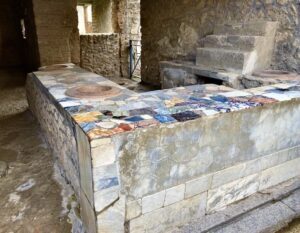
________________________________
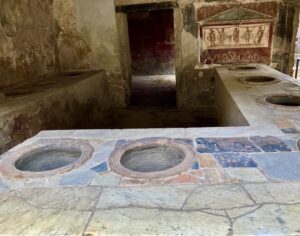
________________________________
In 2019 and 2020, archaeologists conducted excavations, investigations and studies of one very remarkable thermopolium. Designated in the technical literature of the find as the Thermopolium of Regio V, or in popular literature as The Snack Bar, the site yielded a rich array of decorative still life paintings on its structural elements, as well as food residues, animal bones, amphorae, and even victims of the eruption. First to emerge from excavations were decorations painted on the snack bar counter, which included an image of a Nereid riding a sea-horse, and on its shorter side an illustration interpreted to be a depiction of the shop itself, illustrating amphorae, the same or similar to actual amphorae unearthed within the snack bar space itself. Further excavation revealed illustrations of animals likely butchered and sold in the shop, as bone fragments of the animals were also discovered within dolia (jars) containers embedded in the counter. The containers clearly held these food items ready for sale to customers, such as two upside down mallard ducks and a rooster. Also illustrated on the counter structure is a dog on a lead. Of note is an inscription in the frame of the dog painting with the words NICIA CINAEDE CACATOR -Nicia being a name and the other two words translated as Shameless Shitter It is thought that this might have been done by a prankster or a person who worked in the shop.
________________________________
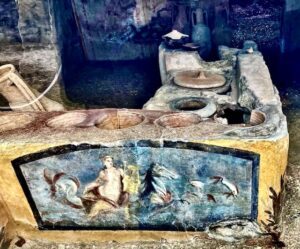
________________________________
In addition, archaeologists discovered a scattering of human bones, left dispersed and disarticulated on the floor of the shop by looters. Despite their disarray, investigators were able to determine that the bones belonged to an individual about fifty years of age who was situated on a bed furnishing (based on the associated space, nails and wood residue beneath the body remains) at the time of the volcanic pyroclastic flow. Bones of another individual were recovered, placed possibly by previous excavators inside a dolium.
Finally, a variety of pantry and transport objects were found, including nine amphorae, a bronze patera, two flasks and a common ceramic table olla.
Specialists are conducting ongoing analyses of the artifacts found within the thermopolium.
_____________________________
_____________________________
The Domus of Leda and the Swan
The Domus (or house) of Leda and the Swan was encountered during intervention work along the Via del Vesuvio. The structure was named after the impressive fresco painting found in what was identified as a bedroom. The subject of the painting focuses on the myth about Jupiter (Roman version of the Greek god Zeus), transformed into the form of a swan, and Leda, the wife of Tindar, king of Sparta. The story originates from Greek mythology, in which the god Zeus, in the form of a swan, seduces or rapes Leda. According to later Greek mythology, Leda bore Helen and Polydeuces, children of Zeus, while at the same time bearing Castor and Clytemnestra, children of her husband Tindar. According to various versions of the story, Jupiter took the form of a swan and had sexual intercourse with Leda on the same night she slept with her husband, King Tindar.
This painting (see below) is not the only treasure unearthed in this room. The room also features refined decorative elements, including floral ornaments, griffins with cornucopias, flying cupids, still life subjects and scenes of animal fights. Also connected to this room is a partially excavated atrium, with colorful walls and a fresco of Narcissus, who is depicted mirrored in water. The atrium also features traces of stairs leading to an upper floor. Finally, one of the walls of the atrium is adorned with a brightly colored figure of Hermes (Mercury).
This discovery is now open to the public for viewing.
______________________________
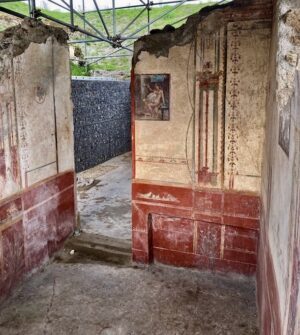
Above: Remains of room featuring Leda and the Swan restored, as now shown to the general public.
______________________________
The House of the Lararium
During the process of conducting maintenance operations on Regio V in 2018, archaeologists excavated a sumptuously decorated lararium of a house. Used as a room by the household for religious worship, it featured a wall that had a niche dedicated to protective deities, and below this a representation of two ‘agathodaemon’ serpents, or ‘good’ daemons that would assure good fortune and prosperity. The lararium also consisted of walls with landscape paintings that included plants and birds, as well as hunting scenes.
But the most spectacular discovery emerged while excavating immediately surrounding lower and upper rooms of the household in 2021. During this operation, excavators uncovered remarkable evidence of furnishings and small artifacts that opened a window on middle class life in Pompeii.
Stated Massimo Osanna, Italy’s Director General of Museums:
“In the Roman Empire there was a significant proportion of the population which fought for their social status and for whom the ‘daily bread’ was anything but taken for granted. It was a social class that was vulnerable during political crises and famines, but also ambitious to climb the social ladder. In the House of the Lararium at Pompeii, the owner was able to embellish the courtyard with the lararium and the basin for the cistern with exceptional paintings, yet evidently funds were insufficient to decorate the five rooms of the house, one of which was used for storage. In the other rooms, two on the upper floor which could be reached by a mezzanine, we have discovered an array of objects, some of which are made of precious materials such as bronze and glass, while others were for everyday use. The wooden furniture, of which it has been possible to make casts, was extremely simple. We do not know who the inhabitants of the house were, but certainly the culture of otium (leisure) which inspired the wonderful decoration of the courtyard represented for them more a future they dreamed of than a lived reality.”*****
The Rooms of the Lower Floor
All furnishings of one room were recovered by excavating voids left in the cinerite (hardened volcanic ash from the eruption) and then filling the voids with liquid plaster to create casts after hardening. One of the rooms contained a bed, with some of the frame still preserved, a pillow showing the texture of its fabric, with a cot that featured a rope netting over which fabric was laid. Next to this is a wooden chest, which appeared to have been left open in the moment the occupants fled during the eruption. Beams and planks from the ceiling above the chest had collapsed upon it. The chest was decorated with a sigillata plate and a double-spouted lantern. Adjacent to this was a small, circular three-legged table, upon which still rested a ceramic cup that contained two glass ampoules, a sigillata plate and glass plate. Next to the table rested a glass ampoule and small jugs and amphorae. The room and its furnishings reflected a moment frozen in time — the last moments of its existence before destruction.
The other room appeared to be a simple storage room. Here, two casts yielded a shelf holding amphorae, and a group of wooden planks bound with cords. Because the planks appeared to be of different sizes, types and finishes, archaeologists believe they were used for different projects, from furniture to building repairs. Just outside the room in a hallway archaeologists discovered a wooden cabinet featuring at least four doors. The cabinet was measured to be about 2 meters high. It had at least five shelves, with the top one holding small jugs, amphorae, and glass plates.
The Rooms of the Upper Floor
The structure and objects of the upper rooms had collapsed into the lower rooms. Among the objects, archaeologists produced a cast of waxed tablets — seven triptychs that were tied together by a cord. They were likely stored on a shelf, and were found among other ceramic and bronze artifacts. Remains of a cupboard with ceramic vessels that would have been used in the kitchen and a canteen, as well as sigillata and glass vessels, were also found. Adjacent was a set of bronze vessels. Finally, a cradle-shaped incense burner was discovered.
Discoveries at Civita Giuliana
In an area as rich in buried cultural heritage as Pompeii, it has naturally become a target for illicit digging activity for individual gain in terms of the antiquities that can be obtained. Government authorities stepped in at one site to halt the activities of grave robbers. That investigative intervention and excavation led to the discovery and recovery of a series of rooms within a large, well-preserved suburban villa, which included, just to start, a variety of artifacts such as amphorae, kitchen utensils and part of a wooden bed, from which a cast was made.
“…….. this was a prestigious estate, with richly frescoed and furnished rooms, and sumptuous sloping terraces facing onto the Gulf of Naples and Capri, as well as an efficient servant’s quarter, with a farmyard, oil and wine warehouses and densely cultivated lands, even according to the first investigations of the early twentieth century”, stated former Director General Massimo Osanna.
Most remarkably, further excavations led to some additional surprises:
Horses
One of the rooms, identified as a stable, contained the remains of several horses, and clues to at least one elaborate military harness. One of the horses, laying on its right side, appeared to be still tied to a trough, presumably unable to free itself during the volcanic conflagration. Another was laying on its left side, with its iron bite still preserved under its jaw. Excavation of this horse yielded five bronze finds: Four, reworked of conifer-wood, were coated in bronze lamina and half-moon shaped. They were located on the rib cage. The fifth object, consisting of three hooks with rivets, was found under the belly area, near the horse’s hind limbs. Archaeologists suggest that they were part of a four-horned saddle, a type used by the military in the Roman Empire since the 1st century AD. They uncovered four ring joints for each harness. Ring joints were used to connect the leather straps to secure the saddle on the horse’s back. Evidence of plant fibers gave clues to a cloth/mantle. A space between the front and hind legs suggested the presence of a bag.
These horses, said Osanna. “must have belonged to the ‘noblest breed’ of display animals, as indicated by their imposing size – likely the result of selective breeding – and the quality of their iron and bronze harnesses.”
The Processional Chariot
Perhaps the most sensational find from the Civita Giuliana villa excavations can arguably be attributed to the results of a meticulously executed excavation of an elaborately decorated 4-wheel chariot discovered within a double-level portico. The portico opened to an uncovered courtyard and was also connected to the stable where the horses were unearthed. Early phases of the excavation focused on excavating, clearing and removing the collapsed remains of the wooden ceiling, characterized by a network of beams, all carbonized as a result of the eruption. But as they continued to excavate, they came across an iron artifact that hinted at a much larger artifact or feature to come. As archaeologists carefully excavated through the covering of volcanic material that had anciently flooded into the portico during the eruption, they eventually uncovered the remains of a 4-wheeled chariot, beautifully preserved in almost every detail. Moreover, the archaeologists could see that this was not a simple chariot used for common transportation and agricultural commerce. It was a pilentum, a type of chariot used by the Roman elite class for ceremonial purposes. This was a rare find.
Its decorative detail gives clues to its significance and purpose: It features large iron wheels with a light carriage that supports a seat surrounded by metal arm and back rests for one or possibly two passengers. The carriage is adorned on both sides with engraved bronze sheet and wood panels painted in red and black. The rear of the chariot features registers with bronze and tin medallions illustrating figurative scenes. The medallions are set in bronze and surrounded by reliefs of male and female figures in erotic scenes. Other smaller medallions depict cupids and the lower part of the chariot features a small, bronze female herm wearing a crown. Said Massimo Osanna, former Director of the Archaeological Park of Pompeii:
“What we have is a ceremonial chariot, probably the Pilentum referred to by some sources, which was employed not for everyday use or for agricultural transport, but to accompany community festivities, parades and processions. This type of chariot, which has never before emerged from Italian soil, bears comparison with finds uncovered around fifteen years ago inside a burial mound in Thrace (in northern Greece, near the Bulgarian border). One of the Thracian chariots is particularly similar to ours, even if it lacks the extraordinary figurative decorations that accompany the Pompeian find.
The scenes on the medallions which embellish the rear of the chariot refer to Eros (satyrs and nymphs), while the numerous studs feature erotes. Considering that the ancient sources allude to the use of the Pilentum by priestesses and ladies, one cannot exclude the possibility that this could have been a chariot used for rituals relating to marriage, for leading the bride to her new household.”*
_____________________________
_____________________________
More Human Victims
While investigating other parts of the villa, archaeologists encountered human remains in a room adjacent to a cryptoporticus, or covered walkway. The cryptoporticus was constructed with archways that supported rooms above. The human remains were clearly those of victims of the eruption. They belonged to two young men, one in his late teens or early 20’s and the other in his 30’s, who died side-by-side. The younger man, who was a little over 5 feet tall, had compressed vertebrae, suggesting a life of labor (a servant?). He wore a tunic. The older man (the master?), about 5 feet, 4 inches tall, wore a mantle and tunic. Evidence for bundles of cloth were found near the remains of the men.
Archaeologists knew these details about the men by analyzing the excavated bones and laser-scanning and filling the voids within the immediate hardened ash context with plaster. The resulting casts were detailed enough to show the folds of what was determined to be woolen material of their tunics.
What were these men doing in this room during the final minutes of their lives? Further study and analysis may present some suggested answers. In any case, like the many examples from previous excavations at Pompeii, these finds have added an additional dramatic chapter to the tragic yet captivating legacy of the doomed city.
The Room of the Slaves
As if the discovery of the processional chariot was not spectacular enough, one can imagine the excitement of the archaeologists when they uncovered something, in some ways, even more sensational — the incredibly preserved lodging space of some of the villa workers who serviced the chariot and stabled horses that were uncovered only a matter of a few feet away. The room contained three wooden beds and a wooden chest that stored metal and fabric items determined to be parts of the horse harnesses. A chariot shaft still rested on one of the beds, of which a cast was made. The beds consist of wooden planks and web bases made of ropes, supporting fabric blankets. Imprints and plaster casting proved instrumental in identifying them. Two of the beds are about 1.7 meters long and one is about 1.4 meters, suggesting the latter was used by a youth or child. Other objects, such as amphorae, ceramic jugs and a ‘chamber pot’ were located beneath the beds. The room, very simple with no decorative elements, also featured a small window.
Archaeologists suggest the room was also used as a storage space, as eight additional amphorae are located jumbled together in the corners of the room.
Said Gabriel Zuchtriegel, Director General of the Pompeii Archaeological Park:
“This is a window into the precarious reality of people who seldom appear in historical sources that were written almost exclusively by men belonging to the elite, and who as a result risk remaining invisible in the great historical accounts. It is a case in which archaeology helps us to discover a part of the ancient world which we would otherwise know little about, but which is nonetheless extremely important. What is most striking is the cramped and precarious nature of this room, which was something between a dormitory and a storage room of just 16 sqm, which we can now reconstruct thanks to the exceptional state of preservation created by the eruption of AD 79. It is certainly one of the most exciting discoveries during my life as an archaeologist, even without the presence of great ‘treasures’ – the true treasure here is the human experience, in this case of the most vulnerable members of ancient society, to which this room is a unique testimony.”***
_____________________________
_____________________________
The Tomb of Marcus Venerius Secundio
Discovering ancient skeletal remains of people who lived millennia before our time is exciting enough, but uncovering articulated skeletons still retaining some of the soft tissue they sported in life can arguably be described as rare and sensational. This is exactly what archaeologists encountered during excavations at the necropolis of Porta Sarno, just to the east of Pompeii. Here they found a monumental tomb featuring a commemorative inscription to the tomb’s owner, Marcus Venerius Secundio, who was buried within the tomb. The inscription refers to performances at Pompeii that were conducted in Greek, the first direct archaeological evidence for this practice. The tomb structure, dating to the early 1st century AD, is surrounded by a worked stone enclosure. There is evidence of paint still visible on the tomb façade, illustrating green plants with a blue background.
Perhaps the most remarkable discovery was the condition of Marcus Venerius’s internment, constituting one of Pompeii’s best preserved skeletons. He was buried in a small space behind the tomb’s main façade. Forensic analysis revealed that he was an adult male over 60 years old. The funerary chamber in which his remains rested was hermetically sealed at his burial, creating conditions that resulted in exceptional preservation — hair on the head and the soft tissue of an ear were both still visible upon excavation. Grave goods were associated with his burial, including two glass unguentaria and many fragments of fabric.
Within the tomb enclosure excavators recovered two cinerary urns, one belonging to a woman named Novia Amabilis. In the Roman period, cremation was a widely used method of disposing of the dead, whose ashes were sometimes placed in glass cinerary urns. Usually only small children were buried. This makes the burial of Marcus Venerius very unusual.
Said Professor Llorenç Alapont of the University of Valencia:
“We still need to understand whether the partial mummification of the deceased is due to intentional treatment or not. Analysis of the fabric could provide further information on this. From the sources we know that certain textiles such as asbestos were used in embalming. Even for those like me, who have been specialized in funerary archaeology for some time, the extraordinary wealth of information offered by this tomb, from the inscription to the burials, the osteological finds and the painted façade, is exceptional, which confirms the importance of adopting an interdisciplinary approach, such as that conducted by the University of Valencia and the Archaeological Park during this project”.****
The excavation and recovery operations of the tomb were conducted by the University of Valencia, led by Prof. Llorenç Alapont of the Department of Prehistory and Archaeology. Also participating were archaeologist Luana Toniolo, restorer Teresa Argento and anthropologist Valeria Amoretti of the Pompeii Archaeological Park.
_______________________________
_________________________________
The House of the Chaste Lovers
When one thinks of the destruction of ancient Pompeii, more often than not the vision of a great racing pyroclastic cloud of super-heated ash comes to mind. This is the common narrative, and it is accurate. But perhaps less discussed and documented is the deadly earthquake that accompanied the Vesuvius cataclysm. For at least some of the remaining inhabitants during the event, it was the earthquake, not the volcanic conflagration, that spelled their primary demise. A recent case in point emerged when archaeologists encountered the skeletal remains of two victims while excavating several rooms as a part of safety measures to renovate roofing and secure the sides of the excavation of what has been designated the Insula of the House of the Chaste Lovers. The remains were found lying on one end of a utility room, where they had apparently fled for greater protection.
Forensic analysis shows that these individuals likely died from multiple bodily traumas from the collapse of the building’s structure surrounding them, and that they were two males at least 55 years old.
While removing parts of one of the skeletons, evidence of organic matter emerged, likely a bundle of fabric, which contained coins — two silver denarii, one a Republican denarius dated to the mid-second century BC and a denarius dated to the reign of Vespasian, and three bronze coins, re-minted but dated to the age of Vespasian. Additionally, in the same location they recovered five elements of glass paste, thought to be beads of a necklace.
Also in this room excavators found an amphora leaning against a corner wall near one of the skeletons, as well as an assemblage of vessels, jugs and bowls that had been stacked against a wall.
Most telling was the clear damage caused to two walls, which appeared to be earthquake damage. One of the walls appeared to have collapsed upon one of the men. His raised arms indicate his dramatic attempt to protect himself in vain from the collapse. At the same time, the upper section of the west wall became detached as a result of the motion of the earthquake and fell inward, killing and burying the other man.
In an adjoining room a kitchen counter made of stone was discovered. Archaeologists suggest that at the time of the eruption in 79 AD, it was temporarily out of use — they found a pile of powdered lime on the counter, which they suggest may have evidenced repair work being conducted at the time. In addition, Cretan amphorae, typically used to transport wine, were discovered along a wall, as well as a domestic shrine depicting the household gods above the counter and a pot placed into the wall, possibly used for religious offerings. Finally, a narrow room was unearthed adjacent to the kitchen. It contained a latrine that was connected to a drainage system beneath a nearby street.
Regio IX
Archaeologists began conducting new investigations in February, 2023 in Regio IX, an area that encompasses a block of the city that still remains unexcavated.
Here, two atrium houses were explored, though they were partly investigated in the 19th century. These structures were originally Samnite houses but they were converted to workshops during the 1st Century AD. A laundry facility was established in place of the atrium of one of the houses. It featured tubs and work benches. Also found was a bakery with an oven, including areas for millstones and rooms for food processing. In these rooms, the skeletal remains of three individuals were found.
Forensic analysis shows they were two adult women and a 3 – 4-year-old baby. Resting on the floor, trauma evidence suggests they died from a collapsing attic. Fragments of the attic were found mixed with white pumice lapilli, indicating the event took place during the first phase of the eruption.
Two frescoed cubicles were also discovered during the initial excavations. They depict mythical scenes that include the gods Poseidon, Ammonia, Apollos and Daphne. In addition, a remarkable still-life fresco painting was found in the atrium of the house that was connected to the bakery. According to the interpretation of the archaeologists, it depicts an assortment on a silver tray that includes a wine cup, a flat focaccia that features various fruits, spices, a kind of pesto, perhaps condiments, dried fruits, yellow strawberry trees, dates and what appears to be a pomegranate. A recent news release about this fresco issued by the Archaeological Park of Pompeii states:
“Such genre of images, known in antiquity as Xenia, took inspiration from the “gifts of hospitality” that were offered to guests because of a Greek tradition that came from the Hellenistic period, (III-I centuries BCE). Around 300 of these representations are found in Vesuvian cities; they often refer to the sacred sphere as well as the sphere of hospitality. Until now, we have not had a precise comparison between findings; the recently discovered fresco amazes us also because of its high quality of execution. From a passage of Virgil’s Aeneid, (book VII, v.128 sgg.) it is possible to understand the position of fruits and other products of the fields, on sacrificial breads that function as “tables”. This reminds us of the moment in which the Trojan heroes who had finished their meal of fruits, chose to eat the bread which they had used as containers (tables). This showed the realisation of the Virgilian Epos, where a prophecy had stated that the Trojans would find a new homeland when they “arrived on unknown beaches, finished all the food,” and their hunger made them “devour also the tables”.******
Most recently, several major discoveries in Regio IX have captured popular attention. The first, excavated within a large structure named the House of the Thiasos (referencing the procession of the god Dionysus, or the god of wine and ecstasy), has revealed a remarkably well-preserved and beautiful megalography, or frieze with nearly life-sized figures. Almost 100 years older than the time of the eruption of Vesuvius in 79 AD, it extends across three sides of a banquet hall, with a fourth open to a garden. The only other such comparable frieze in Pompeii is found in the Villa of the Mysteries, found 100 years before.
The frieze illustrates the procession of Dionysus, showing bacchantes as dancers and hunters, satyrs playing the double flute or performing wine sacrifice (libation). Central to the composition is a woman with Silenus. She will be initiated into the mysteries of Dionysus, who according to myth dies and is reborn, bestowing the same power on his followers.
_______________________________
Equally significant was the discovery of a large thermal complex (baths) inside a private Domus, or house, that was attached to a large banquet hall. This spatial relationship of the baths to the hall suggests, based on what we know about Roman elite society, a function well beyond luxurious living, designed to facilitate the entertainment and reception/visitation of guests by peddling influence to achieve electoral consensus among its special guests, to promote the candidacy of friends or relatives, make deals, or to support and strengthen the house owner’s social status.
Excavation and first-time discovery accounts for only a small part of the entire operation conducted over recent years under the auspices of the national and local governments of Italy at the site of Pompeii. Preservation, conservation, and restoration all play significant roles in the ongoing ‘re-discovery’ process. Indeed, it is the work of these endeavors that create the face of ancient Pompeii that visitors from the world over come to see.
The House of the Vettii, arguably Pompeii’s most iconic and illustrious Domus, provides perhaps the best example of this. It has recently reopened to the public after many years of intense, careful restoration. In early 2023, the Archaeological Park of Pompeii published a press release that includes a summary of the significance of the results:
“……….Excavated between 1894 and 1896, the House of the Vettii belonged to Aulus Vettius Conviva and Aulus Vettius Restitutus, probably two freedmen brothers who had become rich through commerce in wine. The magnificent paintings and sculptures in the house also reflect the wealth of the territory of Pompeii, where wine was produced for export throughout the Mediterranean, and social mobility which enabled two former slaves to reach the upper echelons of local society.
There are various traces of the life of the poor, in particular a room adjoining the kitchen in the slaves’ quarters which is decorated with small erotic paintings. The room was originally fitted with an iron door to ensure that access was restricted only to adult men. The barrier was removed only a few days prior to the re-opening of the house. It has been suggested that the room was used for prostitution, a hypothesis that appears to be confirmed by the discovery of an inscription on the left wall of the vestibulum (entrance hall). The inscription refers to a woman named Eutychis, “a Greek woman of pleasant manners”, who was offered for two asses (copper coins) (Eutychis Graeca a(ssibus) II moribus bellis). Besides the beauty of ancient art and architecture, this find offers an extraordinary insight into ancient society, its stratification and customs.
“……The House of the Vettii represents the story of the Roman world encapsulated in a single house, the ‘house/ museum’ of the ‘Roman spirit’: it contains mythological frescoes and sculptures made of bronze and marble of exceptional artistic quality which reflect the complex relationship between Greek models and Roman copies, as well as the economic and social life of the city. The owners, who were freedmen and thus former slaves, testify to a level of social mobility which would have been unthinkable two centuries previously. Their wealth stemmed from commerce in agricultural produce from the territory around Pompeii, but it would appear that prostitution was also practiced in their house by a Greek slave woman who belonged to the most deprived groups of society,” emphasizes Gabriel Zuchtriegel, Director of the Archaeological Park of Pompeii.” **
_______________________________
_______________________________
As roughly one third of the ancient city remains unexcavated, there is still much work left to do. Excavation and discovery will attract and inspire the imagination of the public through the popular press. But far beyond this, the continuing work of research, rescue operations, preservation, conservation and restoration will in reality consume much if not most of the time and resources dedicated to the illumination of this ancient city and the invaluable snapshot in time it provides for a deeper understanding of ancient Roman life-ways in the 1st Century AD.
The Archaeological Park of Pompeii and the Italian government entities that support the work at the ancient site will continue to disseminate the latest developments for the public in the ongoing effort. Much more information, images and videos can be accessed at the Archaeological Park of Pompeii website.
Cover Image, Top Left: Alexandra_Koch, Pixabay
______________________________
**http://pompeiisites.org/en/2023/page/2/?post_type=avvisi&cat=69
______________________________
Advertisement
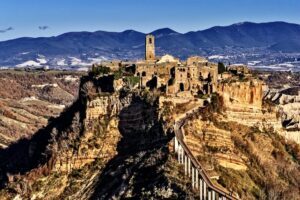
EXPLORE THE ANCIENT ETRUSCANS IN PERSON!
Experience a unique, up-close-and-personal hike among ancient hilltop towns in central Italy. You will walk the sensational countryside of the regions of Umbria and Tuscany, soaking in important sites attesting to the advanced Etruscan civilization, forerunners of the ancient Romans; imposing architectural and cultural remains of Medieval Italy; local food and drink; and perhaps best of all — spectacular scenic views! Join us in this collaborative event for the trip of a lifetime!


